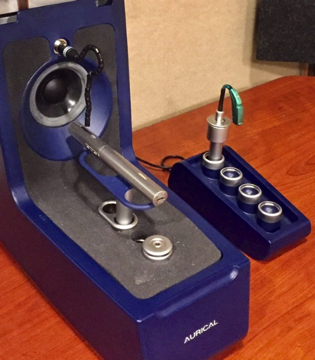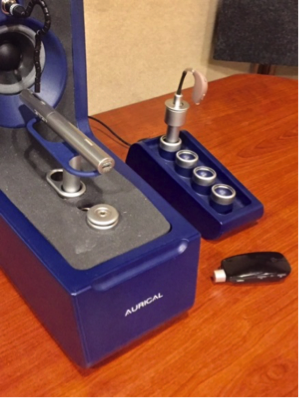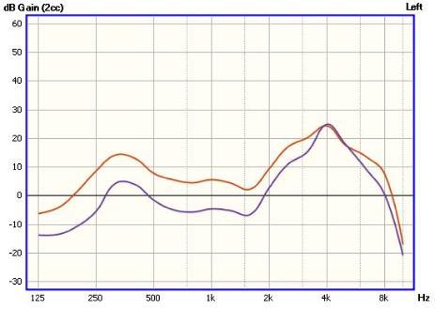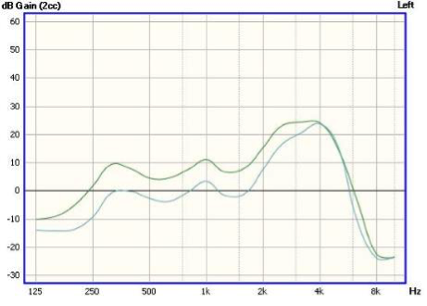Introduction
Hearing is essential to speech and language development, communication, and learning. The presence of any degree of hearing loss at an early age can have a lasting impact on language development. Specifically, children with hearing loss are at risk for developmental delays in receptive and expressive communication skills and often experience learning difficulties, reduced academic achievement, and difficulties communicating and socializing not only with their family but also with their teachers and peers in school (American Academy of Pediatrics, 2007). The classroom environment presents a unique set of challenges for hearing-impaired pupils. Classroom environments often present high levels of background noise, reverberation, and a long distance from the speaker of interest. This places the hearing-impaired student at a significant disadvantage compared to normal-hearing peers. To mitigate these disadvantages, Hearing Assistive Technologies (HAT) have been employed by pediatric audiologists for use in classroom settings. The benefits of HATs are well documented in today’s literature. They are applicable for not only children with hearing loss, but also those with auditory processing deficits, learning disability, auditory neuropathy spectrum disorder, language deficits, and attention deficits, as well as English language learners and those who hear within normal limits (American Academy of Audiology, 2008). The benefits of HATs are intuitive: improvement of the signal-to-noise (SNR) by placing a microphone closer to the target of interest and sending that audio input directly to the user’s hearing devices. This can improve the individual’s speech perception and discrimination in noise, speech understanding at a distance, as well as improve performance and attention in school. The most commonly used HAT devices include frequency modulated (FM) and digitally modulated (DM) wireless remote microphone systems.
FM systems were first introduced in the late 1960s and are widely used in schools. FM systems consist of a transmitter microphone worn by the speaker of interest, and a receiver worn by the listener. The signal from the microphone is sent wirelessly via FM radio technology to the receiver. Early iterations of FM receivers were body-worn devices, but miniaturization led to smaller, ear level receivers that are directly connected to individual hearing devices. Receivers connect to hearing aids via an audioshoe coupler or integrated into behind-the-ear (BTE) hearing aid battery doors, and have been adapted to work with more recently developed hearing technology, including cochlear implants (CIs) and Bone-Anchored Hearing Aids (BAHAs). A traditional FM system delivers a predetermined, fixed gain signal over the environmental microphones of the existing device. Over the years, these types of systems have introduced technical ways to further improve the audibility of the target signal in varying levels of background noise. One system increases the SNR at the level of the receiver, based on the presence of background noise that is located at the level of the transmitter (Wolfe et al., 2009; Thibodeau, 2010). A similar type of adaptive technology also allows for an automatic adjustment for increasing noise levels compared to non-dynamic FM systems. This particular system adaptively increases the SNR based on noise levels located at the ear level (Schafer, Sanders, Bryant, Keeney, & Baldus, 2013).
More recently, a DM operating in the unlicensed 2.4 GHz frequency band (Mulder, 2013), but still offering the adaptive gain at the transmitter level, has begun to supersede FM-based technology. Although this DM system continues to require a receiver as an additional component, the technology follows the trend begun by ReSound to integrate 2.4 GHz digital wireless technology in hearing aids and wireless communication. This technology provides robust and secure connections that are applicable for hearing aid programming, inter-device communication (ear-to-ear), remote control from a dedicated device or smartphone app, telephone use, and audio streaming from external sound sources, including remote microphones. By using the 2.4 GHz band for this technology, it is possible to incorporate both proprietary and standardized communication protocols, such as Bluetooth and Bluetooth Smart. The ReSound Multi Mic is the remote microphone in the ReSound system that can stream sound directly to users’ hearing aids. Because it uses the ReSound proprietary communication protocol rather than Bluetooth, it can stream to an infinite number of ReSound wireless hearing aids within range. In addition to picking up a talker’s voice and streaming it to the hearing aids, the Multi Mic offers a discreet plug and play solution that is directly compatible with other manufactures’ universal FM and DM receivers.
Opposition from Users
While the benefits of HATs are quite clear, children and teenagers often oppose wearing such devices for a number of reasons, leading to a lack of consistent usage. One often cited reason is social pressures, as students are more inclined to avoid being noticed or perceived as different amongst their peers. Social stigma plays a large factor in a child or teenager’s life and being perceived as different can deter a student from wanting to hand off the equipment to teachers. One investigation highlights the prevalence of social pressures as a deterrent of FM usage (Franks, 2008). This study surveyed students, educators, and parents regarding reasons for student resistance to wearing FM technology. The survey focused on the following factors: social, mechanical, support, comfort, benefit and convenience. Across those surveyed, the most commonly cited reasons for FM non-usage were social factors. FM receivers and audioshoes can add size and weight to their hearing aids, making them more visible to peers. This can lead to the perception that the FM receivers and audioshoes are clunky and outdated. If the FM system appears to be socially ostracizing, the hearing-impaired student will be less motivated to utilize the system regardless of the benefits. Students do not want external equipment connected to their hearing aids, adding visibility and weight at the ear level nor do they want the burden of wearing body worn technology making things appear outdated.
Student motivation is not the only factor in consistent FM usage. Teacher motivation with the equipment also plays an important factor and has helped dictate whether the HATs are used on a daily basis. A common scenario in schools is the idea that teachers believe they are speaking loudly enough, rendering the equipment to be inconsequential. Nevertheless, even with preferential seating for the hearing-impaired student, the teacher is unlikely able to replicate the degree of benefit that FM systems can provide. If the teacher has to turn away from the student, the FM system input is unaffected, which can help to compensate the student’s loss of access to visual cues and the decrease in volume. The other critical issue here goes beyond the teacher’s volume, and that is environmental stimuli that the teacher cannot control. Background noise and room reverberation have a substantially negative impact on speech perception for hearing-impaired listeners, even at fairly low levels (Anderson et al, 2004). When properly utilized, HATs can overcome these negative environmental factors without a major behavioral change from the teacher.
While social stigma is often cited as a deterrent of FM usage, students are not opposed to the concept of streaming, and in fact, with the advances of streaming technology, students are becoming more receptive to integrating technology with their hearing aids. In a recent survey from The Ear Foundation, students in the UK were asked about streaming technology in their hearing aids. When the concept of audio streaming to their devices was explained, 96% of those surveyed reported that they thought a wireless system would be useful and was appealing to them (Athalye, Archbold, Yen Ng, & Allen, 2015). What this study did not ask, however, is whether the students would be willing to attach additional hardware to their hearing aids in order to stream audio.
New Affordable and Compatible Classroom Solution
HATs have traditionally been a significant added expense to hearing aids. In some educational settings, HATs are provided to students, but only for classroom use. Even when HATs are owned or available for use outside the classroom, students are hesitant to do so. One reason may be the social issues already discussed. Another report on use of and attitudes towards FM in a group of youths aged 11 to 20-years-old found that while most of them used FM regularly in the classroom, very few used it in any other situations, such as playing sports or being at home (The Ear Foundation, 2014). This was in spite of the participants being able to identify potential benefits of doing so. Reasons given for not using the systems outside of the class were lack of perceived ownership, wind noise outdoors, safety issues if the system involved wearing a device with a lanyard, fear of damaging or losing the equipment, and perceived lack of need outside of school.
The ReSound Multi Mic is a unique solution that meets the needs of students and teachers as well as offering an affordable solution outside the classroom. The microphone has a robust, clear and stable signal with a data transfer rate of up to 2 megabits per second, a streaming delay of less than 20 milliseconds, and operates on a 2.4 GHz platform. The device encompasses a dual microphone system for the unexpected situations that often occur within a classroom. Directional microphones allow a better signal to noise ratio when students are confronted with challenging listening situations, while an omnidirectional mode can be used as a tabletop microphone for small group work. The wireless capability allows for an extended hearing range, up to 80 feet and a battery life of 11 hours on a single charge. In addition, a 360 degree, durable, rotating clip allows the device to clip to any piece of clothing or lanyard. As a precautionary measure, when the Multi Mic drops over 30 inches, it will automatically activate a drop detection mute feature preventing any loud impact sounds. The Multi Mic does not require any intermediary device or hardware and streams the signal of interest directly to the ReSound hearing instruments, offering a truly wireless solution for children, teens and adults without the burden of connecting various accessories.
What makes the Multi Mic solution flexible and cost effective is its true compatibility with HATs from other manufacturers, including the Phonak Roger technology. Phonak Roger is promoted for schools and the benefits of its adaptive, noise dependent gain are documented, but financial and mechanical obstacles remain. Specifically, to stream audio input from the Roger or any FM system, two FM receivers are typically required (one for each ear). This can be a financial barrier for parents and schools. Additionally, the Roger system faces the same mechanical on-ear issues that any other conventional FM system faces: reduced usage due to social pressures. The ReSound Multi Mic is directly compatible with the Roger X universal receiver when plugged into the three-pin euro accessory port, all while maintaining the proven adaptive gain advantage. To further the device’s flexibility and cost effective solution, only one universal receiver is required to stream FM/DM to the student’s hearing aids, binaurally. This removes any need for audio shoes on the student’s devices and brings the FM receiver off the ear, drawing less attention to the student’s hearing aids and reducing social pressures. The teacher is then only required to connect the two systems by plugging them together, at which point, the Multi Mic can sit anywhere in an 80 foot radius of the student with clear line of sight. One Multi Mic can be used and stream to an infinite number of ReSound wireless hearing aids. The microphone is also directly compatible for streaming to the Cochlear N6, N7 and Kanso cochlear implants. Therefore, the students wearing ReSound hearing instruments and/or Cochlear N6, N7 and Kanso implants do not require multiple receivers, thus eliminating any need for receivers at the ear level.
Validation
Audiologists may be uncertain as to whether the adaptive gain advantage exists when the Phonak Roger system is combined with the ReSound Multi Mic, or whether this benefit is reserved for users of the particular manufacturer’s hearing aids. Electroacoustic verification is a critical first step to ensure proper functionality and demonstrate the SNR and the adaptive gain advantage. This was accomplished using the Otometrics Aurical Hearing Instrument Test box (HIT) with OTOsuite software. First, measurements were made using a Phonak Sky Q M13 hearing instrument with a Roger 15 integrated receiver. The Roger Pen microphone with the microphone manually switched into interview microphone mode was placed inside the HIT box, where it was exposed to the test stimuli. The hearing aid was mounted to the external coupler, where the transmitted sound from the microphone could be measured (Figure 1). One quiet and one noisy test condition were used:
- ISTS babble at 75 dB SPL input presented with pink noise at 75 dB SPL for a 5-second interval – capturing the gain settings prior to the adaptive gain increase
- ISTS babble, 75 dB SPL with pink noise in 30-second intervals, capturing the gain settings after the adaptive gain increase

Figure 1. For validation of the adaptive gain, the Roger Pen microphone was placed inside the HIT box and the Phonak Sky hearing aid was mounted on the external coupler for measurement.
Comparative measurements were then made using a ReSound LiNX2 988 hearing instrument and a Roger X universal receiver plugged into a ReSound Multi Mic that streamed directly to the hearing aid. The Roger microphone was placed inside the HIT box. The universal Roger X receiver was plugged into the euro accessory port on the ReSound Multi Mic, which was placed outside the HIT box. The LiNX2 hearing aid was mounted to the external coupler to capture the sound being streamed from the ReSound Multi Mic (Figure 2).

Figure 2. For validation of the adaptive gain using the ReSound Multi Mic, the Roger Pen microphone was placed inside the HIT box, and the Roger X universal was plugged into the ReSound Multi Mic. The Multi Mic was placed outside the HIT box and set up to stream to the ReSound LiNX2 hearing aid, which was mounted on the external coupler for measurement.
For both the Phonak Sky hearing aids and the ReSound LiNX2 hearing aids, the devices were set based on the same audiogram, and were programmed based on the DSL v5 (child) fitting rule. Figure 3 illustrates how the gain was increased in the noisy condition when the Roger microphone streamed to the Phonak Sky hearing aid. Likewise, Figure 4 shows a similar result with the Roger X connected to the Multi Mic, which streamed to the LiNX2 hearing aid. Importantly, a boost in gain was demonstrated for the noisy condition regardless of which setup was tested. This confirms that the adaptive gain of the Roger system occurs at the receiver level, and is available to any compatible device/hearing aid.

Figure 3. Phonak Sky Q M13 hearing instrument with Roger 15 integrated receiver. The purple curve was measured with ISTS babble at 75 dB SPL with pink noise and is the pre-adaptive gain adjustment. The red curve shows the post-adaptive gain adjustment for ISTS babble at 75 dB with pink noise. The difference between the two curves shows the adaptive gain benefit.

Figure 4. ReSound LiNX2 hearing instrument with Roger X universal receiver streaming via Multi Mic. The blue curve was measured with ISTS babble at 75 dB SPL with pink noise and is the pre-adaptive gain adjustment. The green curve shows the post-adaptive gain adjustment for ISTS babble at 75 dB SPL with pink noise. The difference between the two curves shows preservation of the adaptive gain benefit.
Summary
HAT systems are widely used in schools today for students who have hearing loss and for those who hear within normal limits. Having an FM/DM system helps provide benefit to overcome the deleterious effects on the signal when distance, reverberation and background noise play a key factor. Phonak systems with Adaptive FM Advantage are the most commonly recommended for educational settings, and have proven benefits on speech recognition in the presence of noise. Being able to access that benefit while cutting costs and keeping solutions wireless and innovative is important in today’s educational systems. As demonstrated with the Aurical HIT equipment, preservation of the Adaptive FM Advantage is possible when using ReSound hearing instruments with a Phonak Roger X universal receiver streaming with ReSound Multi Mic technology. This suggests several opportunities for audiologists and educators to take advantage of innovative and cost effective approaches to fitting students with HATs. The ReSound Multi Mic solution offers a truly wireless system for its users and does not require any additional accessories worn at the ear level. Thus making for a lighter weight, discreet system on a pediatric ear and without having to use any body worn intermediary device. The Multi Mic also offers several alternative solutions that can be connected to virtually any device with a telecoil, line-in and DAI. Having various solutions will assist students and teachers when connecting to other types of HATs. With the rising costs of educational technology, having a cost effective solution is imperative in today’s classrooms. Educators who plug the Phonak Roger X universal receiver to the ReSound Multi Mic are not required to wear the remote microphone and can place the microphone anywhere within its 80 foot operating range. They can then stream to an infinite number of students utilizing ReSound and/or Cochlear technology, at one time, binaurally, while keeping the Adaptive FM Advantage through one single receiver. This solution provides an instant cost savings for educators both in the short and long term, as students will have less equipment to be responsible for wearing and perhaps losing. Taking the FM equipment off the ear may also help reduce the negative social impact that students may have experienced with other equipment, leading to increased FM utilization. The ReSound solution offers an affordable, wireless, seamless solution inside and outside the classroom for everyone.
References
American Academy of Audiology. (2008). Remote microphone hearing assistance technology for children and youth from birth to 21 years. Retrieved from https://www.audiology.org
American Academy of Pediatrics, Joint Committee on Infant Hearing. (2007). Year 2007 position statement: principles and guidelines for early hearing detection and intervention programs. Pediatrics, 120, 898-921.
Anderson, K.L. & Goldstein, H. (2004). Speech perception benefits of FM and infrared devices to children with hearing aids in a typical classroom. Language, Speech, and Hearing Services in the Schools, 35, 169-184.
Athalye, S., Archbold, S., Yen Ng, Z., & Allen, C. (2015). Views of teenagers and young adults on wireless hearing technology and communication. Report by The Ear Foundation, available from www.earfoundation.org.uk
Franks, J.L. (2008). Why do students with hearing impairment resist wearing FM amplification? (Master's thesis). Available at: https://successforkidswithhearingloss.com/wp-content/uploads/2014/06/FM_Acceptance-Franks-article.pdf
Mulder, H. (2013). Phonak Insight. Roger -The new wireless technology standard [White paper]. Retrieved from www.phonakpro.com
Schafer, E.C, Sanders, K., Bryant, D., Keeney, K., & Baldus, N. (2013) Effects of voice priority in FM systems for children with hearing aids. Journal of Educational Audiology, 19, 12-24.
The Ear Foundation. (2014). FM technology: Teenagers’ views. Available from www.earfoundation.org.uk
Thibodeau, L. (2010). Benefits of adaptive FM systems on speech recognition in noise for listeners who use hearing aids. American Journal of Audiology, 19(1), 36-45.
Wolfe, J., Schafer, E. C., Heldner, B., Mulder, H., Ward, E., & Vincent, B. (2009). Evaluation of speech recognition in noise with cochlear implants and dynamic FM. Journal of the American Academy of Audiology, 20(7), 409-421.
Citation
Quilter, M., & Wright, N. (2017, October). An innovative and cost effective approach to wireless remote microphones in schools. AudiologyOnline, Article 21242. Retrieved from www.audiologyonline.com



